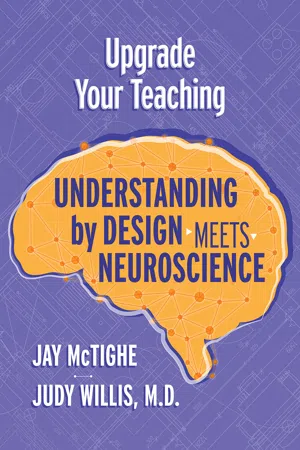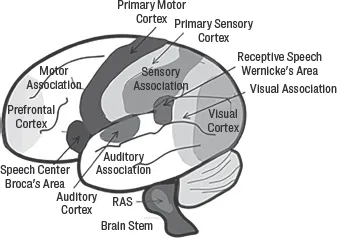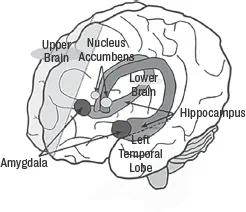![]()
Chapter 1
How the Brain Learns Best
. . . . . . . . . . . . . . . . . . . .
The brain is always changing, as a result of environment and experience. Every lesson, assignment, and interaction shapes your students' brains. Understanding how the brain converts information into learning provides keys to the best instructional strategies and learning experiences.
As a result of breakthroughs in neuroscience research, including neuroimaging and neuroelectric monitoring of neurons (brain cells) firing, we now can observe how the brain responds during learning. These technologies provide visible representations of the brain's response to instructional practices, revealing neurological activity as information travels from the body's sensory intake systems through the attention and emotional filters, forming memory linkages and activating the highest cognitive networks of executive function. This research has illuminated our understanding of how various factors—classroom environment, activation of prior knowledge, attention-getting techniques, use of graphic organizers, mental manipulations, and others—influence the transformation of sensory information into networks of durable long-term memory and conceptual understanding.
As you build your knowledge of the strategies that promote optimal brain processing, you'll recognize that neuroscience research may well support strategies you've already found most successful in your experience as an educator. Our goal is to help you increase your understanding of why "best practice" strategies and tools work at the neurological level.
The RAS: The Brain's Attention Filter
All learning begins with sensory information. Our brains are constantly bombarded with information from the body's sensory receptors. Continuous data reports flow from specialized sensory systems (hearing, vision, taste, touch, smell) and from the sensory nerve endings in our muscles, joints, and internal organs. These receptors do not evaluate the data. They just transmit constant status reports. Of the millions of bits of sensory data available each second, only about 1 percent are admitted to the brain, whose various areas are associated with different functions, as shown in Figure 1.1. Once information enters the brain's processing systems, it is relayed by numerous "switching stations." Ultimately, conscious or higher-level processing takes place in the outer covering of the brain, called the cortex.
Figure 1.1. Functional Areas of the Brain
One reason for restricting the enormous amount of sensory input is that the brain is rather stingy with its mental effort because it needs to preserve its limited fuel. Unlike other organs, it has no stored nutrients or oxygen. The average brain weighs only about three pounds, but it is so dense and metabolically active that it requires over 20 percent of all the oxygen and nutrients the body consumes. From a survival standpoint, it makes good sense for the brain to be a couch potato!
Because it is impossible for the brain to consciously sort through all the sensory information that is available every second, it is programmed to prefer selected input. To deal with this selection, the brain has a sensory intake filter, called the reticular activating system (RAS), in the lower part of the posterior brain (see Figure 1.1). The RAS determines what the brain attends to and what information gets in. Its involuntary programming gives priority to sensory information that is most critical for mammals to survive in the unpredictable wild. Any change in the expected pattern can signal a threat of death or, alternatively, a source of nutrients that can help ensure survival. This "hard-wired" criterion of selection for entry is essentially the same for humans as for other mammals; the brain gives priority admission to sensory input about change in the expected pattern—what is new, different, changed, unexpected.
Students are often criticized for not paying attention, but we now know that failure to focus on a teacher's instruction does not mean the student's brain is inattentive. A student's RAS is always paying attention to (letting in) sensory input—but not necessarily the input being taught at that time.
The Amygdala: The Brain's Switching Station
Deep within the brain is the emotionally responsive limbic system, which includes two structures (one on each side of the brain) called the amygdalae, which direct communication between the lower brain and the upper brain (Figure 1.2). The lower brain is the more primitive control center that directs bodily functions that are largely automatic, such as breathing and digestion, as well as reactions that are largely involuntary, such as the fight-or-flight response. The upper brain, known as the prefrontal cortex (see Figure 1.1), is where memory is constructed and neural networks of executive functions guide voluntary behavior with reflective, rather than reactive, choices.
Figure 1.2. The Brain's Limbic System
The amygdala can be thought of as the switching station for traffic flow between these upper and lower structures in the brain. After sensory information is selected to enter through the RAS, the level of activity taking place in the amygdala determines whether the information will travel down to the lower, involuntary, reactive brain or up to the reflective and memory-storing "thinking brain" (the prefrontal cortex).
Information perceived as possibly threatening is directed through the amygdala to the reactive lower brain. Input passing through the amygdala to the prefrontal cortex finds the home of logical thought, judgment, emotional self-management, and other executive functions needed to generate more accurate predictions about new information and direct more considered responses.
When a mammal is in a state of actual or perceived stress, new information does not freely pass through the amygdala's filter to gain access to the prefrontal cortex. Instead, input is diverted to the lower, reactive brain, which has a limited set of behavioral responses that can be summarized as involuntary survival responses to a perceived threat. In fact, it is these primitive mammalian responses that we are likely to observe in students when they are highly stressed by fear, frustration (e.g., as a result of repeated failure to succeed in a task or subject), alienation, anxiety, or sustained boredom (e.g., when they are asked to do lessons or drills on topics they have already mastered or that they see as irrelevant). Here are some examples of specific school-related stressors that can trigger the amygdala to send input to the lower, reactive brain:
- Anxiety related to speaking in class, answering questions, or oral presentations
- Fear of being wrong
- Physical and language differences
- Test-taking anxiety
- Boredom as a result of prior mastery or absence of personal relevance to the material
- Frustration with material students believe exceeds their understanding
- Feeling overwhelmed by the demands of school assignments
- Inability to effectively organize time in response to the demands of academics, extracurricular activities, and out-of-school chores and jobs
- Feelings of isolation or lack of acceptance by peers or teachers
During these states of stress, students are likely to display involuntary lower-brain responses, manifested in acting-out or zoning-out behaviors.
The Brain and Mindset
Because the brain seeks to preserve its limited energy resources, it directs its behaviors based on the probability that the effort expended will result in success. Understanding this survival programming provides new perspective about students' choices and responses. It is now evident that low intelligence, lack of initiative, or laziness may not be the most likely reasons students don't always remain fully attentive, remember everything they are taught, persevere at tasks, or manage their emotions. A more fundamental explanation for nonproductive student behaviors is rooted in the brain's design, which focuses sensory intake, reacts to stress with survival responses, preserves its resources, and minimizes outputs of effort.
The brain's expenditure of voluntary effort is linked to the expectation of positive outcomes. If students fail after repeated efforts to achieve goals and academic challenges, their willingness to put forth effort will decline. These negative self-expectations can grow progressively year after year with repeated failures, further compromising the likelihood of academic success. Psychologist Carol Dweck (2007) has coined the phrase fixed mindset to characterize the conviction of those learners who do not believe that their effort can lead to achievement and is therefore fruitless. This contrasts with a growth mindset, which attributes success to effort, perseverance, and use of strategies.
In survival terms, withholding effort when past experiences predict failure is beneficial for animals in the wild. Consider a fox living in a region where prey is limited and whose den is surrounded by three hills. One of those hills is particularly steep and covered by dense underbrush where the prey hides. To repeatedly chase prey up that hill is to exert effort—in this case, energy—without the likelihood of achieving the goal of an energy-restoring meal. In the interest of survival, the fox's brain ultimately develops a mindset that deters it from chasing prey up that particular hill.
As students' efforts toward achieving a goal repeatedly fail, they might develop the fixed mindset that their intelligence and skills are predetermined, limited, and unchangeable. They become less likely to expend the effort necessary to persevere on challenging learning tasks, and they fall behind academically. Without the needed foundation of knowledge and skills to understand subsequent instruction, the gap widens further and they become even more susceptible to the stress-related blockades.
Seeking Patterns to Make Predictions
The brain's programming promotes survival of the animal and the species. This programming has guided mammalian development and adaptations for survival in the unpredictable and perilous environments in which most mammals live. The human brain continues to follow two prime survival directives: to seek patterns and pleasure. These directives drive the brain's memory, effort, and actions.
Patterning refers to the brain's meaningful categorization and organization of sensory data based on relationships or commonalities. The brain stores new information by linking it to patterns of related information already stored in neural circuits of existing memory. These clusters of related information stored together in memory are what psychologist Jean Piaget (1957) described as cognitive frameworks, or schemas.
It is through this pattern matching with previously constructed and related neural networks that our brains recognize and make meaning of the thousands of bits of sensory input received every second. By linking information newly stored in memory networks with relevant prior knowledge, the brain can sift through the barrage of ongoing input to make sense of the world. Storing information in memory by relationship patterning allows for easier, more efficient retrieval of information, which is essential to interpreting and predicting, and enacting the best response to something new.
All animals must make predictions to survive. For example, based on frequent links between cold temperatures and the behavior of the local rabbits in its hunting territory, a fox's brain might establish a memory pattern. The memory would result from frequent repetition of the pattern of cold temperatures linked to rabbits entering their dens earlier in the evening. Therefore, on a cold evening, the fox might predict that the time to catch its dinner is earlier than usual, perhaps just as the sun goes down.
When presented with novel sensory input, such as change, unfamiliar questions, or choices, our brains rapidly self-scan the related patterns for those that match the new information. Our brains activate these stored memories to relate to the new input and to make predictions and choose actions guided by those memory patterns.
Prediction is successful whenever the brain activates enough information from a patterned memory category to interpret the pattern of the new input. For example, if you see the number sequence 2, 4, 6, 8…, you predict the next number will be 10 because you recognize the pattern of counting by twos. Depending on the result of the prediction, the existing patterns relied upon to make the prediction are extended, fortified, or revised.
Through observations, experiences, and feedback, the brain increasingly learns about the world and can make progressively more accurate predictions about what will come next and how to respond to new information, problems, or choices. This ability for prediction, guided by pattern recognition, is a foundation for successful literacy, numeracy, test taking, appropriate social-emotional behavior, and understanding.
Successful prediction is one of the brain's best problem-solving strategies. To ensure that we will repeat the actions arising from accurate predictions, the experience of making accurate predictions stimulates a pleasure response mediated through the release of the neurochemical dopamine.
Dopamine: The Brain's Pleasure Drug
If you know pleasure, you know dopamine. Seeking and experiencing pleasure are innate survival features of the brain. When dopamine is released throughout the brain, it promotes feelings of pleasure, a deep satisfaction, and a drive to continue or repeat the actions that triggered the pleasurable response.
You might already be familiar with dopamine in its other function as a neurotransmitter. Neurotransmission involves axons and dendrites, two kinds of extensions of neurons that act as senders and receivers, respectively, of neural electrical signals. Dopamine carries these signals from the axons of one neuron, across a liquid-filled gap called a synapse, to the dendrites of another neuron.
The action of dopamine that is relevant to the pleasure or reward response derives from triggers that stimulate its release from a holding center called the nucleus accumbens, found near the amygdala (see Figure 1.2). This increase in circulating dopamine is seen in all mammals and activates those feelings you experience as intrinsic pleasure and satisfaction.
Making correct predictions is one of the strongest dopamine elevators. The dopamine-reward response to making accurate predictions promotes survival in mammals because the intrinsic pleasure that comes from accurate predictions drives the brain to remember and use memory circuits that have guided previously successful predictions. Experiencing accurate predictions and the resulting satisfaction of goal achievement leads the brain to remember the related choices, behaviors, actions, decisions, and responses and to seek more opportunities to repeat them. Concomitant effects include enhanced attentive focus, motivation, curiosity, memory, persistence, and perseverance.
There are intrinsic impediments to optimally processing learning through the brain. As you've read, the RAS and the amygdala are filters programmed to determine what information gets through and where it is directed.
To further optimize students' success in school, you can engage the dopamine-reward response to motivate the brain to put forth the mental effort needed for new learning. This is true even for things that are not immediately recognized as relevant or pleasurable. Academic effort can be stimulated by tapping into the brain's programming to focus attention and apply effort when pleasure is the anticipated expect...


